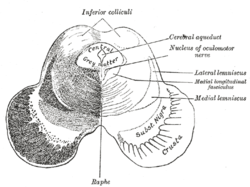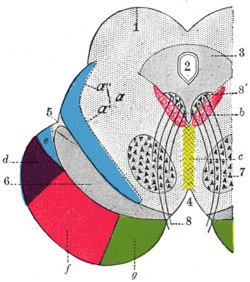Medial longitudinal fasciculus
| Medial longitudinal fasciculus | |
|---|---|

Transverse section of mid-brain at level of inferior colliculi. (Medial longitudinal fasciculus labeled at center right.)
|
|

Axial section through mid-brain.
1. Corpora quadrigemina. 2. Cerebral aqueduct. 3. Central gray stratum. 4. Interpeduncular space. 5. Sulcus lateralis. 6. Substantia nigra. 7. Red nucleus of tegmentum. 8. Oculomotor nerve, with 8’, its nucleus of origin. a. Lemniscus (in blue) with a’ the medial lemniscus and a" the lateral lemniscus. b. Medial longitudinal fasciculus. c. Raphé. d. Temporopontine fibers. e. Portion of medial lemniscus, which runs to the lentiform nucleus and insula. f. Cerebrospinal fibers. g. Frontopontine fibers. |
|
| Details | |
| Identifiers | |
| Latin | fasciculus longitudinalis medialis |
| NeuroNames | ancil-743 |
| NeuroLex ID | Medial longitudinal fasciculus |
| TA |
A14.1.04.113 A14.1.05.304 |
| FMA | 72618 |
|
Anatomical terms of neuroanatomy
[]
|
|
The medial longitudinal fasciculus (MLF) is one of a pair of crossed fiber tracts (group of axons), on each side of the brainstem. These bundles of axons are situated near the midline of the brainstem and are composed of both ascending and descending fibers that arise from a number of sources and terminate in different areas. MLF is the main central connection for the oculomotor nerve, trochlear nerve, and abducens nerve. The vertical gaze center is at the rostral interstitial nucleus (riMLF).
The MLF ascends to the interstitial nucleus of Cajal, which lies in the lateral wall of the third ventricle, just above the cerebral aqueduct.
The medial longitudinal fasciculus carries information about the direction that the eyes should move.
It connects the cranial nerve nuclei III (Oculomotor nerve), IV (Trochlear nerve) and VI (Abducens nerve) together, and integrates movements directed by the gaze centers (frontal eye field) and information about head movement (from cranial nerve VIII, Vestibulocochlear nerve). It is an integral component of saccadic eye movements as well as vestibulo-ocular and optokinetic reflexes.
It also carries the descending tectospinal tract and medial vestibulospinal tracts into the cervical spinal cord, and innervates some muscles of the neck and upper limbs.
...
Wikipedia
